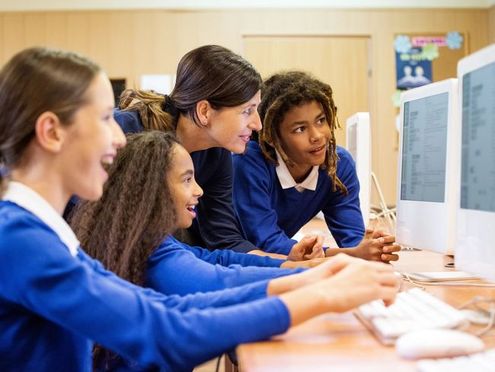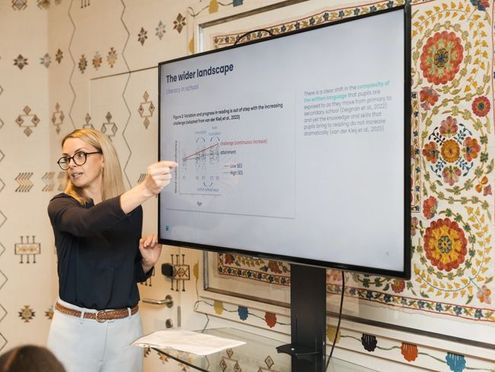With literacy as the foundation that unlocks access to education, this article explores the potential for Pupil Premium funding to support individualised literacy learning and close the language gap.
What is the attainment gap?
Pre-pandemic figures show that the attainment of children from lower-income households is around 4.6 months behind their peers in higher-income households when they enter primary school; this increases to 9 months by the time they leave primary school and 18 months by the time they leave secondary school. Since then, the pandemic has disrupted schooling and led to a loss of learning, with disadvantaged children feeling the impact the most.
While research is ongoing and figures are gradually emerging, the need for support for socially disadvantaged students is likely to be greater than pre-pandemic times. A study of learner attainment in KS2 projected that the disadvantage gap had widened for the first time in a decade due to the impact of COVID-19. This puts renewed pressure on schools to look at how they are supporting those children and using funding, such as Pupil Premium, to address inequalities in educational outcomes.
What is Pupil Premium?
The gap in academic achievement across socioeconomic groups starts at an early age and widens as children make their way through the school system. This is in part because disadvantaged children are more likely to lack the foundational knowledge they need to access and benefit from the curriculum, and may require additional support as they progress through school.
Pupil Premium was introduced in 2011 as additional funding for schools to help address this disparity. Evidence suggests that the funding is making a difference in schools, with progress where there is strong and committed leadership, robust reporting and tracking of progress of eligible students. However, with a predicted widening of the attainment gap due to the pandemic, schools need to review their activities and assess the potential pitfalls.
Potential pitfalls of Pupil Premium
The amount of Pupil Premium a school receives depends largely on the number of pupils it has that qualify for Free School Meals (FSMs), a measurement that is not a failsafe way of identifying those at a disadvantage. FSM eligibility is based on receiving certain benefits and excludes many low income households experiencing ‘in-work poverty’. With rising costs of living, the cohort of learners who are not supported financially is likely to expand.
Then there are those children at educational and social disadvantage due to factors other than income, such as negative household perceptions around the value of education, who do not qualify for FSM yet require additional support. Those that do qualify have varying educational and support needs and creating a support system in which they all benefit from the expenditure of the Pupil Premium they’ve brought to their schools is hard to achieve.
Identifying needs for targeted interventions
The Education Endowment Foundation (EEF) recommends a tiered approach to spending Pupil Premium that aligns with Department of Education guidance to focus spending across the following three areas:
- high quality teaching;
- targeted academic support; and
- wider strategies to address non-academic barriers to success in school.
The first step of the tiered approach is to identify the needs of disadvantaged students and gain clarity on how they are performing compared to national benchmarks. Where attainment is lower than expected, schools should dig deeper to find out what is holding those students back, combining academic-related diagnostics with assessment of the wider challenges, such as attendance and behaviour.
Assessment of needs leads to targeted interventions where support is most required and for some pupils this might mean a requirement for individualised learning instruction, particularly in key subject areas, such as literacy. Small group and one-to-one tuition are listed in the government’s menu of approaches that schools should consider when spending Pupil Premium, as are interventions to support language development and literacy. Focusing individualised learning on literacy, therefore, falls within the remit of Pupil Premium spending.
Schools don’t have to spend Pupil Premium so it solely benefits eligible pupils. They can use it wherever they identify the greatest needs. This opens up the conversation to look at creating more targeted literacy interventions that include individualised learning for all students without the literary skills to access the curriculum as a whole.
What is individualised learning in literacy?
Individualised learning involves creating different tasks for each learner and providing support at an individual level. Learning to read involves complex linguistic and cognitive processes and support for low performing students needs to match their particular reading ability and vocabulary scores. For example, if a child is struggling with decoding, they might need a focus on phonics; if comprehension is low, they might need one-to-one reading and discussion time.
When children fall behind their peers, it’s about reverse engineering the support provided so that it tackles the area of weakness and bolsters the foundational knowledge. This means regular assessment across literacy skills to understand vocabulary, decoding, comprehension, spelling and writing levels at individual level.
The benefits of individualised literacy learning
Literacy levels are relevant for accessing all areas of the curriculum, impacting a learner’s ability to understand lessons, use subject-specific language, act on instruction and share knowledge through exams and assessment.
Research shows that individualised learning is highly effective throughout a learner’s educational journey, from Reception to Further Education. Taking a targeted approach to meeting literacy learning needs as early as possible in the educational journey can open up the curriculum to those children from language poor households, including, but not restricted to, those that are FSM eligible.

Individualised literacy instruction
Bedrock's literacy curriculum uses a deep-learning algorithm to differentiate instruction, improving learning and literacy.
What does individualised literacy learning mean for Pupil Premium learners?
Literacy learning outcomes align well the goals of Pupil Premium. This is because of the link between low literacy levels and social disadvantage in children, who often have less exposure to books and reading from an early age due to their background. Evidence suggests that children who own books are six times more likely to read above the level expected for their age, compared to children who don’t own books. It is disadvantaged children who are most likely not to own books.
Disadvantaged children often start school life with a low volume of vocabulary and without phonological and phonemic awareness for learning to read. Studies identify expanding vocabulary as an important factor in determining academic achievement, while research shows reading ability to have a considerable impact on educational attainment. This places literacy at the core of activities designed to close the attainment gap.
Overcoming the challenges of individualised literacy learning
Undoubtedly, one of the biggest challenges of individualised literacy learning is the resource it requires. According to the EEF, there is evidence that digital technology can be used effectively as part of an individualised instruction approach. Digital one-to-one instruction has been used effectively alongside small group tuition, with teachers focusing on providing additional targeted support as required.
In a survey of teachers on the use of technology to support literacy, three in five believe technology can help pupils overcome barriers to learning. Teachers believe technology can have a particularly positive impact on reluctant readers and writers, as well as less able readers and writers.
Students from disadvantaged backgrounds are less likely to have access to digital technology. However, technology investment is included on the government’s menu of approaches for spending Pupil Premium and making technology more accessible could help unlock the benefits of individualised literacy learning for those that need it most.
How Bedrock Learning provides targeted academic support
In a class of 20-30 learners, even the most talented teacher would find it impossible to differentiate learning for every student - and now, time for teachers is more limited than ever. In order to offer learners truly differentiated, personalised academic support, teachers need support from automated, intelligent educational technology solutions, such as Bedrock Learning.
Bedrock’s Alpha test and deep-learning algorithm use technology to differentiate literacy instruction for every learner. For vocabulary instruction, learners are placed in one of nine blocks best suited to their reading ability, ensuring they are challenged but that the texts they are reading are accessible. In our grammar curriculum, mastery tasks assess learners’ confidence with new grammatical skills, and recap tasks ensure the learners who need additional support receive it.
While educational technology is no replacement for a teacher in the classroom, Bedrock’s core curriculum utilises the time-saving benefits of technology to offer teachers an efficient, consistent, self-marking solution that makes teaching that bit easier.
And Bedrock Learning does make it easier. In fact, a recent study found that just under 50% of teachers using Bedrock Learning found literacy teaching easy or very easy, compared to an average of 36% of teachers who are not using Bedrock Learning. With 96% of all teachers agreeing vocabulary and grammar are vitally important to learners’ progress, ensuring their explicit instruction is targeted is crucial.
To discover how Bedrock can help you offer targeted academic support for your literacy instruction, find out more about the core curriculum or get started with a free trial at your school.




